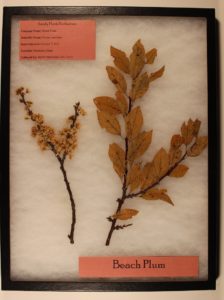| Common Name(s) | Beach Plum | ||||
| Scientific Name | Prunus maritima | ||||
| Family | Rosaceae | ||||
| Location/Vegetative Zone | Secondary Dune, Thicket, Maritime Forest | ||||
| Flowering Period | Late Spring, Early Summer | ||||
| Identifying Characteristics | Grows up to 13 feet in height, has white flowers with alternating leaves with serrated edges | ||||
Description
• A shrubby deciduous plum native to North America
• It can grow up to 13 feet in height. At these heights, the stems will grow to a size of 4 to 8 inches in diameter.
• The fruit that grows on the plant ranges in color from purplish-black to red; in rare cases, yellow coloring occurs.
• The flowers are white in color and grow up to ¼ to ½ inch across. They grow clusters of two or three flower heads.
• The egg shaped leaves are dull green in color, firm, and alternate. The texture on top is rough and ridged while the bottom is paler and finely hairy. They grow up to 1 ½ to 2 ½ inches in length and are serrated at the edges.
Location
Medicinal/Edible Uses
• Sold as fruit to stores and used in jams, wines, etc.
• Used as food for birds and other wildlife
Cultural Uses
- Leaves used to make green dye
- Fruit used to make dark green/gray dye
Misc
• Partially wilted beach plum trees contain seeds with hydrocyanic acid, an acidic agent that has been linked to the death of many livestock grazing in the area with the plant.
• All seeds found inside the plum are poisonous.
• Attacked by several insects, including the plum curcilio
• Named by plant taxonomist Humphrey Marshall in 1785.
• One of the first plants seen by the New World colonists of the seventeenth century.
Sources
“Prunus maritima”. Practical Plants. 4 May 2013. Web.
2,385 total views, 2 views today

